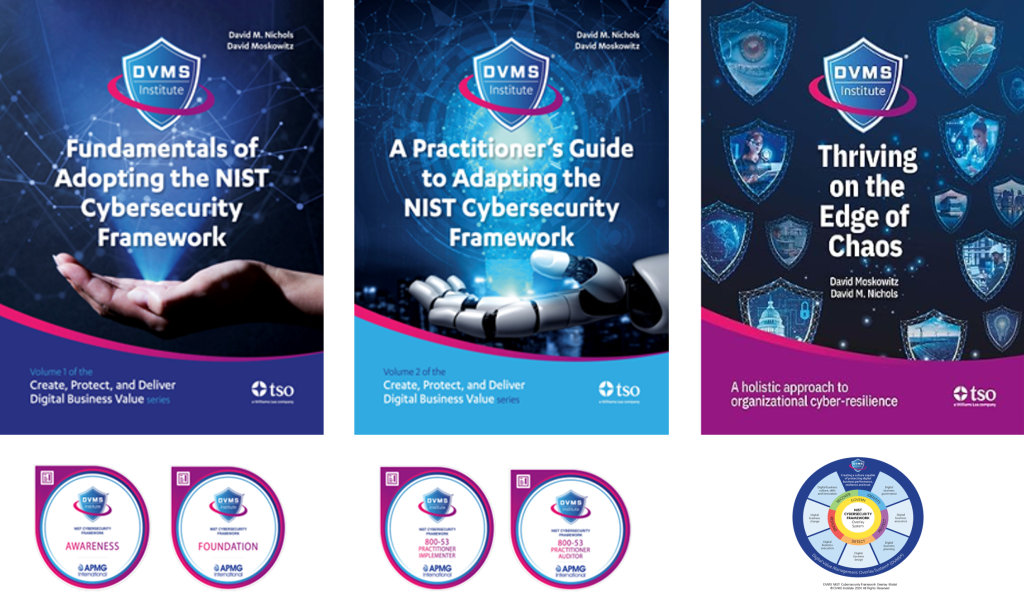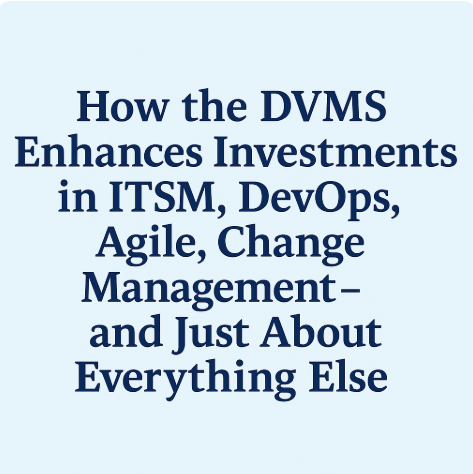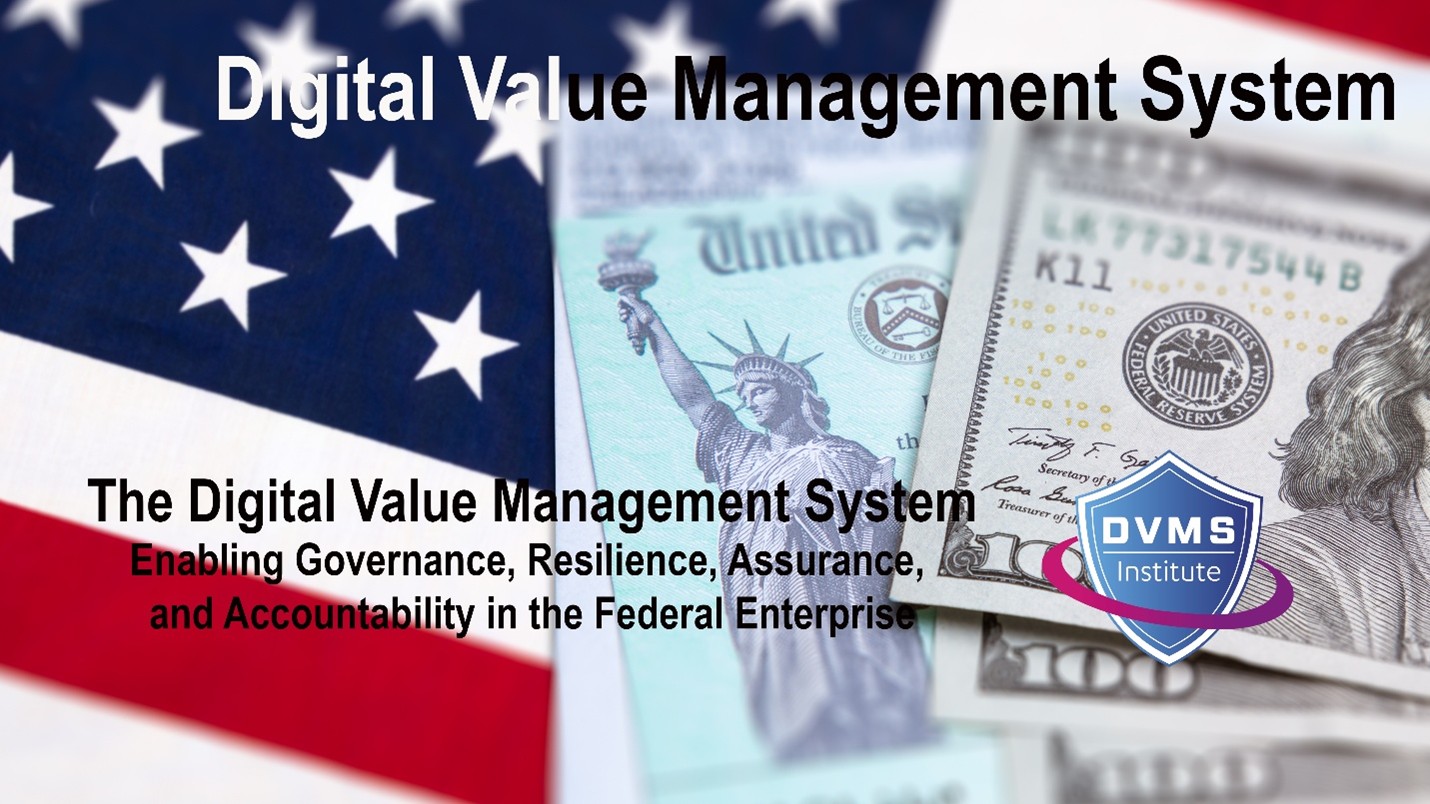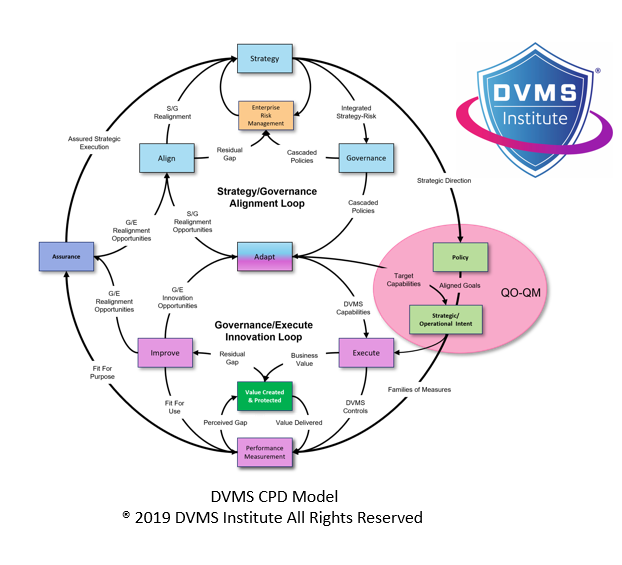How the DVMS Enhances Investments in ITSM, DevOps, Agile, Change Management…and Just About Everything Else
Rick Lemieux – Co-Founder and Chief Product Officer of the DVMS Institute
Reframing Capability Investment through the DVMS Overlay
The Digital Value Management System® (DVMS) enhances organizational investments in IT Service Management (ITSM), DevOps, Agile, and Change Management by providing a systems-based overlay that aligns these practices with the broader mission of creating, protecting, and delivering digital business value. Rather than operating in silos, the DVMS treats these disciplines as interconnected components within a complex adaptive system, allowing them to function cohesively as part of a value-focused enterprise model.
The DVMS does not replace frameworks like ITIL, Agile, or DevOps; instead, it overlays them to provide visibility into how their existing capabilities contribute to the minimum viable capabilities (MVCs) of the organization—Govern, Assure, Plan, Design, Change, Execute, and Innovate. This overlay enables organizations to map what they do to a common language and structure, exposing performance gaps, redundant controls, and opportunities for integration and optimization.
Elevating ITSM from Operations to Strategy
ITSM traditionally ensures operational stability, service quality, and incident resolution. The DVMS expands this scope by linking ITSM processes with organizational governance and strategy. For instance, within the DVMS Z-X Model, ITSM practices are mapped across the “Execute,” “Assure,” and “Govern” capabilities, showing their influence beyond day-to-day operations.
This systems-based mapping helps ITSM become an enabler of organizational resilience by ensuring that service management supports risk-informed decision-making, adaptability, and alignment with strategic business outcomes. DVMS encourages organizations to see incidents not as discrete events, but as learning opportunities that inform risk, innovation, and customer experience strategies.
DevOps in the Context of Continual Innovation
DevOps focuses on speed, collaboration, and automation to deliver high-quality software faster. However, DevOps can become counterproductive when unmoored from enterprise risk and governance structures. The DVMS addresses this by embedding DevOps within the broader digital value system, ensuring rapid development does not sacrifice resilience or compliance.
The Innovate capability of the Z-X Model embraces DevOps’ incremental, sustaining, adaptive, and disruptive innovation paradigms, transforming DevOps from a set of engineering practices into a strategic lever for organizational transformation. Additionally, integrating DevOps into the DVMS ensures its activities are risk-informed and strategically aligned, which is essential for resilience in a dynamic threat landscape.
Agile Transformation as a Systemic Change
While Agile introduces responsiveness and iterative value delivery, many organizations struggle with fragmented implementations that lose sight of larger strategic goals. The DVMS helps overcome this challenge by positioning Agile methods within a systemic enterprise view. Agile becomes a method that serves the Design, Change, and Execute capabilities within the DVMS, rather than a standalone initiative.
This ensures that Agile practices improve team-level velocity and contribute to enterprise-wide resilience, adaptability, and value protection. By embedding Agile into the CPD Model (Create, Protect, Deliver), the DVMS turns Agile into a tool for both performance improvement and cybersecurity readiness.
Change Management as a Lever of Cultural and Structural Adaptation
Traditional Change Management often fails because it addresses only technical or procedural transitions. The DVMS elevates Change Management by viewing it through the lens of complex system behavior and cultural inertia. In the Z-X Model, Change is one of the seven minimum viable capabilities, essential for managing systemic adaptation in response to internal and external pressures.
Change within the DVMS is not a project phase but a continuous organizational competency linked to governance, strategy-risk, and resilience. It explicitly accounts for system latency, interdependencies, and unintended consequences of structural shifts. As such, it becomes a vehicle for cultivating a culture of learning, trust, and continuous improvement.
The Unifying Power of Strategy-Risk and Systems Thinking
What sets the DVMS apart is its unique fusion of systems thinking, enterprise risk management, and cultural transformation. It introduces the concept of “strategy-risk,” the idea that strategic decisions and risk posture are inseparable. This idea reshapes how ITSM, DevOps, Agile, and Change Management are funded, evaluated, and scaled.
Under DVMS, investment in these areas is no longer seen as a cost center or technical necessity but as a core enabler of digital business value. The overlay ensures these investments are made intentionally and are monitored for their contribution to adaptive capacity, stakeholder trust, and strategic resilience.
Conclusion: Integration, Not Isolation
The DVMS overlay system transforms ITSM, DevOps, Agile, and Change Management from disparate operational tools into integrated, strategic enablers. By aligning these practices with governance, strategy-risk, and value delivery, the DVMS ensures that they contribute directly to business resilience, adaptability, and performance. It’s not about doing more with these disciplines; it’s about doing them with strategic intent and systemic coherence.
About the Author

Rick Lemieux
Co-Founder and Chief Product Officer of the DVMS Institute
Rick has 40+ years of passion and experience creating solutions to give organizations a competitive edge in their service markets. In 2015, Rick was identified as one of the top five IT Entrepreneurs in the State of Rhode Island by the TECH 10 awards for developing innovative training and mentoring solutions for boards, senior executives, and operational stakeholders.
In today’s digitally driven economy, cyber disruptions are no longer an “if” but a “when.”
The DVMS Institute’s Certified Training Programs teach organizations the skills to build a Holistic and Culture-Aligned System capable of coordinating Adaptive, Governance, Resilience, and Assurance actions across a Complex Digital Ecosystem.
Achieving true cyber resilience across a complex digital ecosystem requires seamless alignment between organizational Strategy, Governance, and Operations, underpinned by a culture dedicated to sustaining and continuously innovating organizational digital value.

The DVMS positions cyber resilience as a strategic, enterprise-wide capability powered by the Institute’s CPD, Z-X, and 3D Knowledge models.
This systems-based approach to cyber operational resilience demands active engagement from all members of the Digital Ecosystem, with each member playing a distinct role in proactively identifying and mitigating the systemic risks that threaten digital business operations.
This adaptive, forward-looking approach to Governance, Resilience, and Assurance (GRA) positions businesses to:
- Maintain Operational Stability Amidst Constant Digital Disruption
- Drive Agility and Trust Across Your Digital Ecosystem
- Satisfy Critical Regulatory and Certification Requirements
- Leverage Cyber Resilience as a Competitive Advantage
DVMS Explainer Videos
- Architecture Video: David Moskowitz explains the DVMS System
- Case Study Video: Dr. Joseph Baugh Shares His DVMS Story.
- Overlay Model – What is an Overlay Model
- ZX Model – The MVC’s that power operational resilience
- CPD Model – Adaptable governance and assurance
- 3D Knowledge Model – Enabling holistic organizational learning
- FastTrack Model – A phased approach to cyber resilience
Digital Value Management System® is a registered trademark of the DVMS Institute LLC.
® DVMS Institute 2025 All Rights Reserved




